Rising Minimum Wage Taking Its Toll on Domino's Pizza Inc.

Image source: Domino's Pizza
Shares of Domino's Pizza are down nearly 7% since the end of April. The decline was largely fueled by the fast food giant'sdisappointingfirst quarter report. Although sales rose on an annual basis, they missed the analyst consensus, and even worse, earnings similarly fell short of expectations.
Data by YCharts
Domino's slowing growth is likely attributable to rising competition, both within the pizza space and the fast food world in general. But Domino's profitability was also hit by rising labor costs. Changes to the minimum wage in New York City in particular took a toll on Domino's bottom line during the period. Domino's is confident that it can manage around a changing labor environment, but as momentum for a higher minimum wage builds throughout the country, Domino's business could struggle.
$15 an hour by 2018
There were a total of 12,692 Domino's stores operating at the end of the first quarter. Of those, 385 were company-owned with the rest owned and operated by franchisees. The company collects a portion of each franchisee's sales in the form of a royalty rate (5.5% for domestic operators and an average of 3.1% for international ones)but is not responsible for operating costs, including labor. It is, however, responsible for those costs at its corporate stores.
Many of those stores are in New York City. Every Domino's located in the Bronx, Brooklyn, and Queens is company-owned and operated, which means changes in the New York labor market more directly affect Domino's financials. At the beginning of the year, the minimum wage for fast food workers in New York City rose to $10.50 an hour, up from $8.75 previously. More increases are coming, and by the end of 2018, Domino's will be forced to pay its workers in New York City a minimum of $15 an hour.
Although the overwhelming majority of Domino's stores are owned by franchisees, company-owned stores are important to its financials. Last quarter, Domino's corporate stores generated nearly 18% of its revenue and a similar percentage of its gross profit.During the company's April earnings call, CFO Jeff Lawrence cited rising labor costs as a key reason for its lower-than-expected profitability. "The operating margin in our company-owned stores decreased to 24.6% from 26.2%, driven primarily by higher labor rates . . ." he said.
Domino's isn't the only company under pressure
In response, Lawrence explained the company's plans to focus on efficiency. Managers will make do with fewer employees (". . . as the wage rate goes up, stores tend to get better and more efficient about managing labor hours"), relying instead on technology (". . . we have a technology platform that [has] also driven efficiencies and we think gives us opportunities to drive more efficiencies going forward"). In recent years, Domino's has made it a point to invest in online apps and other services to handle orders, reducing the number of employees needed to work the phones. More improvements could come over time.
Domino's management also takes solace in the fact that its competitors face the same problem, and they may not have the scale or the technology to compete as effectively. Lawrence added, ". . . our competition has to deal with all of the same things . . . we feel good about where we are."
Other major fast food restaurants have made similar remarks in recent quarters, includingMcDonald's and Wendy's , which both cited a rising minimum wage as a threat to their business.
In January, McDonald's CFO Kevin Ozan discussed how higher labor expenses dragged on the company's results, ". . . higher incremental labor costs in the U.S. [offset margin gains in the business] . . . [driven partially by] minimum wage increases [in] several states . . . [rising wages] negatively impacted fourth quarter U.S. margins by about 350 basis points," he said.
Meanwhile, Wendy's business is performing well, driven by the successful implementation of its "4 for $4" promotion, but its labor costs are also rising, ". . . [W]e are seeing about 5% to 6% [wage] inflation. Some of that is driven by minimum wage," Wendy's CFO Todd Penegor said during the company's May earnings call. Like Domino's, Wendy's plans to respond by investing in technology. "[Wendy's] will continue to invest in technology . . . like self-order kiosks, mobile order, mobile pay . . . [and] we will continue to invest in the back of the house . . . [to remove] labor around things like temperature controls and checking, scheduling . . ." he said.
Better technology should reduce the labor needs for these companies and mitigate the effects of a rising minimum wage in major markets around the country. However, it's a significant risk factor that investors should watch closely in the years ahead. States like California and New York have implemented strong minimum wage laws. If the federal government or other states follow this trend, just as Washington D.C. recently announced, these businesses could feel the pressure.
The article Rising Minimum Wage Taking Its Toll on Domino's Pizza Inc. originally appeared on Fool.com.
Sam Mattera has no position in any stocks mentioned. The Motley Fool has no position in any of the stocks mentioned. Try any of our Foolish newsletter services free for 30 days. We Fools may not all hold the same opinions, but we all believe that considering a diverse range of insights makes us better investors. The Motley Fool has a disclosure policy.
Copyright 1995 - 2016 The Motley Fool, LLC. All rights reserved. The Motley Fool has a disclosure policy.



















